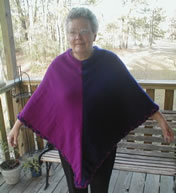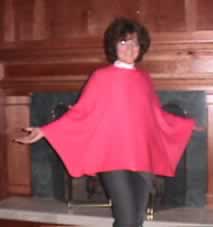Feb. 15, 2004
Lucia Liljegren
Visit
the whole site! Or the blog, poncho index, poncho I or poncho III. And now poncho IV!
My site is supported by your annual $3 donation. Please click the to
make a $3 donation.
Anyway, she replied.. "Well.. I guess I'd like a poncho generator!"
Well... she was the first to use the Poncho II generator. You can
see her poncho, and my poncho and schematics of these ponchos by
clicking Charlene's
Poncho page.
Charlene's question made me realize that I also really, really
needed some ponchos.
The fashion designers have been showing lots of ponchos on the runways,
so I guess they are "in". They are also amazingly practical for travel,
and I'm going to on vacation next week. (I've got to escape freezing
cold Chicago!)
I've written two poncho pattern generators now. The first was hand
knit top down. I made that poncho for my doll. I wanted to gain
confidence with the shoulder shaping and I didn't want to waste
yarn.
Hand knitters will probably like that poncho shape. You
can see that poncho generator here: Poncho
I
So.. my poncho and Charlene's are different from each other, right? Well, you can create patterns for either one at this web page.
As you can see, one poncho is wider than the other. Charlene's poncho and gray poncho below are the style I call "medium" on this page. My pink one is the "wide" version. There are 4 widths all together, and you can choose any on this page.
The gray poncho below is knit from Brown Sheep Nature Spun fingering yarn, which I bought on 1 lb cones. The poncho took about 6-8 ounces of yarn. The gauge is about 7 st/in. The pink poncho is knit from yarn I impulse bought when I passed a yarn store while on vacation 5 years ago. The yarn was cheap, cheap, yeap!!! And it's very soft, warm, and 100% wool. The yarn is amazingly thin; I used 2 strands to obtain a gauge of 8 st/in. (We all have impluse buy yarn... right? And we have no clue what gauge it's going to knit up to? That's why we all need generators!)
Notice the pink "wide" poncho flares out more than the medium poncho. This page permits you to generate ponchos with 4 basic flare types, which I call "slim", "medium", "wide" and "full". Many of the ponchos on the runway are of the "slim" variety, which is slimmer than either shown here. I'm going to knit myself one of those in turquoise tomorrow on Monday, so you'll see a blurry picture of that poncho soon. I also programmed a really, really full poncho, which I call full. See how I'm holding my arms to the side in the pink one? Well, if it were "full", I'd be able to hold them straight out and the poncho would just drape down. I'm not planning to make the "full" poncho. However, the full poncho would be great to wear camping; it would give you lots of room for arm movement.
Anyway, scroll down, and create your own pattern.
Lucia


 Information about ponchos and
this generator.
Information about ponchos and
this generator.